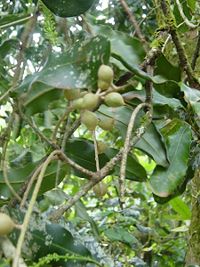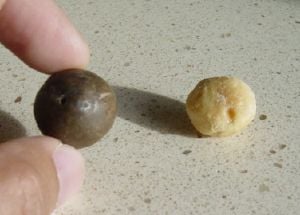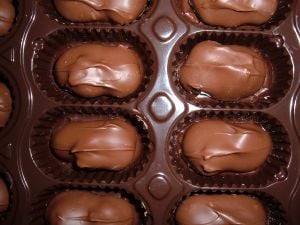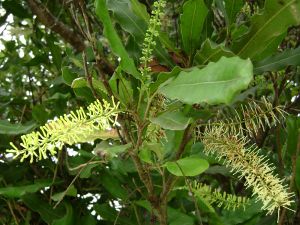Macadamia
| Macadamia | ||||||||||
|---|---|---|---|---|---|---|---|---|---|---|
 Macadamia integrifolia foliage and nuts
| ||||||||||
| Scientific classification | ||||||||||
| ||||||||||
|
Macadamia claudiensis |
Macadamia is a genus name and common name for various tropical evergreen trees comprising ten species in the flowering plant family Proteacea, and in particular the commercially important Macadamia integrifolia and M. tetraphylla of Australia. The name also is used for the round, edible, hard-shelled nut or seed of these trees. In addition to macadamia and macadamia nut, other common names include Queensland nut, Bush nut, Maroochi nut, and bauple nut. There are nine species in the genus, with a a disjunct distribution native to eastern Australia (seven species), New Caledonia (one species M. neurophylla) and Sulawesi in Indonesia (one species, M. hildebrandii). Although originating in Australia, the two commerical macadamias are now a major commercial crop of Hawaii.
slow growing flowers in racemes small hard-shelled, nearly round nut containing one or two seeds
exotic nuts rich flavor oil delicacies dessert nuts M. integrefolia nuts with smooth shells 'M. tetraphylla rough-shelled nuts
Description
of nine species of flowering plants in the family Proteaceae, with .
They are small to large evergreen trees growing to 6–40 feet tall. The leaves are arranged in whorls of three to six, lanceolate to obovate or elliptical in shape, 6–30 cm long and 2–13 cm broad, with an entire or spiny-serrated margin. The flowers are produced in a long slender simple raceme 5–30 cm long, the individual flowers 10–15 mm long, white to pink or purple, with four tepals. The fruit is a very hard woody globose follicle with a pointed apex, containing one or two seeds.
Indigenous Australian names include gyndl, jindilli, and boombera.
The genus is named after John Macadam, a colleague of botanist Ferdinand von Mueller, who first described the genus.[1]
Production
The nuts are a valuable food crop. Only two of the species, Macadamia integrifolia and Macadamia tetraphylla, are of commercial importance. The remainder of the genus possess poisonous and/or inedible nuts, such as M. whelanii and M. ternifolia; the toxicity is due to the presence of cyanogenic glycosides. These glycosides can be removed by prolonged leaching, a practice carried out by some Indigenous Australian people in order to use these species as well.
The two species of edible macadamia readily hybridise, and M. tetraphylla is threatened in the wild due to this. Wild nut trees were originally found at Mount Bauple near Maryborough in southeast Queensland, Australia. Locals in this area still refer to them as "Bauple nuts". The macadamia nut is the only plant food native to Australia that is produced and exported in any significant quantity.[citation needed]
The first commercial orchard of macadamia trees was planted in the early 1880s by Charles Staff at Rous Mill, 12 km southeast of Lismore, New South Wales, consisting of M. tetraphylla.[2] Besides the development of a small boutique industry in Australia during the late 19th and early 20th century, macadamia was extensively planted as a commercial crop in Hawaii from the 1920s.
The Hawaiian-produced macadamia established the nut internationally. However, macadamia production is now falling in Hawaii, with nut production dropping to a 26-year low in 2008 due to bad weather and pests. [3]
Outside of Hawaii and Australia, macadamia is also commercially produced in South Africa, Brazil, California, Costa Rica, Israel, Kenya, Bolivia, New Zealand and Malawi. Australia is now the world's largest commercial producer - at approximately 40,000 tonnes of nut in shell per year, with a total global production of 100,000 tonnes.
Nutritional qualities
Macadamias are highly nutritious nuts. They have the highest amount of beneficial monosaturated fats of any nut. They also contain 9% protein, 9% carbohydrate, 2% dietary fibre, calcium, phosphorus, potassium, sodium, selenium, iron, thiamine, riboflavin and niacin. [4]
Skincare
Macadamia oil is prized for containing approximately 22% of the Omega-7 palmitoleic acid,[5] which makes it a botanical alternative to mink oil, which contains approximately 17%. This relatively high content of "cushiony" palmitoleic acid plus macadamia's high oxidative stability make it a desirable ingredient in cosmetics, especially skincare.
Cultivation and processing
The macadamia tree is usually propagated by grafting, and does not begin to produce commercial quantities of nuts until it is 7–10 years old, but once established, may continue bearing for over 100 years. Macadamias prefer fertile, well-drained soils, a rainfall of 1,000–2,000 mm, and temperatures not falling below 10°C (although once established they can withstand light frosts), with an optimum temperature of 25°C. The roots are shallow and trees can be blown down in storms; they are also susceptible to Phytophthora root disease.
The macadamia nut has an extremely hard shell, but can be cracked using a blunt instrument, such as a hammer or rock applied with some force to the nut sitting in a concave surface, or a custom made macadamia nutcracker can be used. Nuts of the "Arkin Papershell" variety, crack open more readily.
History
- For thousands of years before European settlement the aborigines ate the native nut that grew in rainforests of eastern Australia. One of these nuts was called gyndl or jindilli (Macadmaia integrifolia), which was later corrupted to kindal kindal by early Europeans. In New South Wales, the southern species is known traditionally as boombera (Macadamia tetraphylla). [6]
- 1828 - Allan Cunningham is the first European to discover the macadamia plant.
- 1857 - British botanist Ferdinand von Mueller gave the genus the scientific name Macadamia - named after von Mueller’s friend Dr.John MacAdam, a noted scientist and secretary to the Philosophical Institute of Australia.
- 1858 - Walter Hill, Superintendent of the Brisbane Botanical Gardens, observes a boy eating the nut without ill effect, becoming the first non-indigenous person recorded to eat Macadamia.
- 1860s - King Jacky, Aboriginal elder of the Logan River clan, south of Brisbane, Queensland, is the first known macadamia nut entrepreneur as he and his tribe regularly collect and trade the nuts with settlers.
- 1881 - William H. Purvis introduces macadamia nuts to Hawaii as a windbreak for sugar cane.
- 1882 - First commercial orchard of macadamia nuts planted at Rous Mill, 12km from Lismore, by Charles Staff.
- 1889 - Joseph Maiden, Australian botanist, wrote "It is well worth extensive cultivation, for the nuts are always eagerly bought."[7]
- 1910 - Hawaiian Agricultural Experiment Station encourages planting of macadamia on Hawaii's Kona coast, as a crop to supplement coffee production in the region.[8]
- 1922 - Ernst Van Tassel formed the Hawaiian Macadamia Nut Co in Hawai‘i.
- 1925 - Tassel leases 75 acres on Round Top in Honolulu (Nut Ridge) and begins a macadamia nut orchard, Hawaii's first macadamia nut farm.
- 1931 - Ernest Van Tassel establishes a macadamia nut processing factory on Puhukaina Street in Kakaako; nuts sold as Van's macadamia nuts.
- 1937 - W.W. Jones and J.H. Beaumont reports in "Science," the first successful grafting of macadamia nuts that paved the way for mass production.
- 1940s - Steve Angus, Murwillumbah, Australia, forms Macadamia Nuts Pty Ltd, doing small scale nut processing.
- 1953 - Castle and Cooke adds a new brand of macadamia nuts called "Royal Hawaiian," which is credited with popularizing the nuts in the U.S.
- 1964 - Macadamia Nuts Pty Ltd, opened Australia’s first purpose-built processing plant at Slacks Creek, near Brisbane, Queensland.
- 1997 - Australia surpasses the United States as the major producer of macadamia nuts.[9]
- 2001 - Boo Yong Sia Estate planted 12,000 trees on 400 acres in the State of Johore, Malaysia.
- 2003 - Human nutrition research in Australia shows that macadamia nut lowers total and LDL cholesterol levels.[10]
Trivia
- Macadamia nuts are often fed to Hyacinth Macaws in captivity.[11] These large parrots are one of the few animals, aside from humans, capable of cracking and shelling the nut.
- Macadamia nuts are toxic to dogs. Ingestion may result in macadamia nut toxicosis, which is marked by weakness with the inability to stand within 12 hours of ingestion. Recovery is usually within 48 hours.[12]
- The trees are also grown as ornamental plants in subtropical regions for their glossy foliage and attractive flowers.
- Macadamia species are used as food plants by the larvae of some Lepidoptera species including Batrachedra arenosella.
- Macadamia nuts are often used by law enforcement to simulate crack cocaine in drug stings.[13] When chopped, the nuts resemble crack cocaine in color.
ReferencesISBN links support NWE through referral fees
- ↑ Mueller, F.J.H. von (1857) Account of some New Australian Plants. Transactions of the Philosophical Institute of Victoria 2: 72 Type: Macadamia ternifolia F.Muell.[1]
- ↑ Power, J., Macadamia Power in a Nutshell, 1982, ISBN 0-9592892-0-8, p. 13.
- ↑ "Mac nut production falls", Honolulu Advertiser, July 21, 2008. Accessed 21 July2008.
- ↑ Macadamia nutrition.[2]
- ↑ (German)/(English) [3], Federal Research Centre for Nutrition and Food (Bundesforschungsanstalt für Ernährung und Lebensmittel (BfEL)).
- ↑ Macadamia history. [4]
- ↑ Maiden, J.H., The Useful Native Plants of Australia, 1889, p40
- ↑ Rieger, M., Introduction to Fruit Crops, 2006, p. 260. ISBN 15602225X
- ↑ Rieger, M., Introduction to Fruit Crops, 2006, p. 260. ISBN 15602225X
- ↑ Garg, M.L., Blake, R.J., Wills, R.B.H., Macadamia Nut Consumption Lowers Plasma Total and LDL Cholesterol Levels in Hypercholesterolemic Men, The American Society for Nutritional Sciences J. Nutr. 133:1060-1063, April 2003.[5]
- ↑ Kashmir Csaky (2001). The Hyacinth Macaw.. Retrieved 15 May, 2007.
- ↑ "Macadamia nut toxicosis in dogs", Steven R. Hansen, DVM, MS, DABVT. ASPCA.org. Reprinted with permission from the April 2002 issue of Veterinary Medicine. Accessed 5 June 2007.
- ↑ "Nuts! Cops use holiday treat in drug sting", Chicago Sun Times, December 24, 2004. Accessed 21 November2007.
- Holmes, G. S. 1994. How is a macadamia nut made? In N. Schlager, How Products Are Made. Detroit, MI: Gale Research. ISBN 081038907X.
External links
Credits
New World Encyclopedia writers and editors rewrote and completed the Wikipedia article in accordance with New World Encyclopedia standards. This article abides by terms of the Creative Commons CC-by-sa 3.0 License (CC-by-sa), which may be used and disseminated with proper attribution. Credit is due under the terms of this license that can reference both the New World Encyclopedia contributors and the selfless volunteer contributors of the Wikimedia Foundation. To cite this article click here for a list of acceptable citing formats.The history of earlier contributions by wikipedians is accessible to researchers here:
The history of this article since it was imported to New World Encyclopedia:
Note: Some restrictions may apply to use of individual images which are separately licensed.


